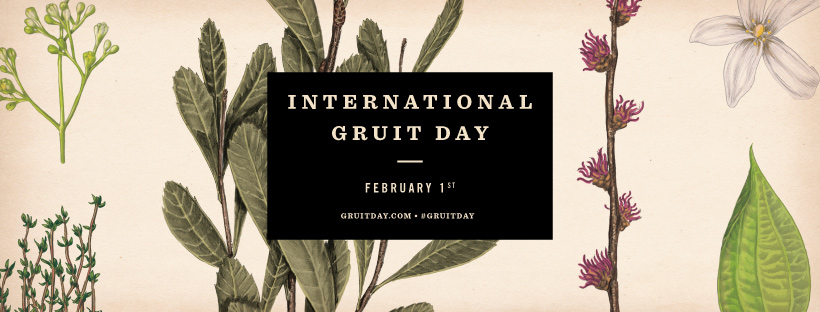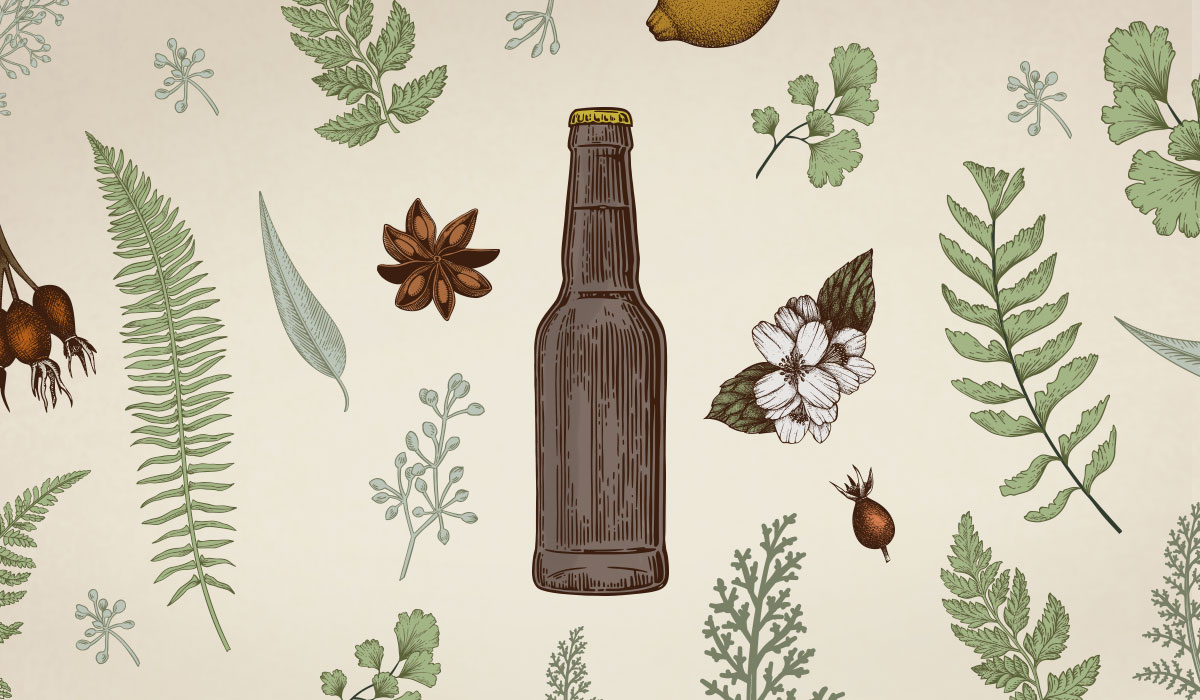It’s hard to imagine a time when hops (Humulus lupulus) were not a primary component of beer, let alone the star of the show. Craft beer fans have an obsession with the green cone-shaped herb that lends many positive attributes to modern day beer. From a bitter counterbalance of malt to amazing flavors, even contributions to head retention and shelf life, hops seem like they were created specifically for your beer.
Brewers in the Middle Ages must have stumbled upon hops and quickly realized their potential as the single best addition to beer, right? Not exactly. For centuries, hops were not the premier addition to malt beers and ales; in some cases, no additions were added to malt at all. Before the Reinheitsgebot dictated that only hops, water, barley and yeast could be used to make beer, there was gruit, the strongly flavored blend of herbs which was mandatory in beer during the Middle Ages. Though these beer types fell out of style, craft brewers worldwide are exploring them again.
(INFOGRAPHIC: How to Pick the Right Beer Glass)
My first experience with gruit ales happened early in my discovery of craft beer. A version was a long-time fixture at Denver’s Wynkoop Brewery. I remember a server pointing out the beers on a sampler tray I ordered: “Here you have our hefeweizen, amber ale, and this is our gruit ale – it tastes like bong water,” explained the server.
It wasn’t exactly the best sell on this ancient beer style, but it did not deter me from giving the deep brown beverage a try. Despite the description, which I assume was apt, I was intrigued. It was strongly antiseptic-like and bitter. The sample may not have been as alluring to me as the Wixa Weiss back in 2005, but it certainly made an impression, and I kept the idea of beers without hops in the back of my mind.
I am Gruit
Gruit ales are essentially beers that are charged with botanicals rather than hops. “Gruit” refers to a specific blend of herbs, not a specific beer style. According to Stephen  Harrod Buhners’ book “Sacred and Herbal Healing Beers,” the traditional gruit employed three herbs: Myrica gale (also known as bog myrtle, yarrow (Achillea millefolium) and wild rosemary, though many believe that the gale and rosemary were used interchangeably. The brewer likely included other herbs to their liking and to differentiate. Randy Mosher described theses herbs in “Radical Brewing” as medicinal, tannic and not generally for public consumption.
Harrod Buhners’ book “Sacred and Herbal Healing Beers,” the traditional gruit employed three herbs: Myrica gale (also known as bog myrtle, yarrow (Achillea millefolium) and wild rosemary, though many believe that the gale and rosemary were used interchangeably. The brewer likely included other herbs to their liking and to differentiate. Randy Mosher described theses herbs in “Radical Brewing” as medicinal, tannic and not generally for public consumption.
I have never tasted bog myrtle or wild rosemary; however, yarrow can be found all over the Northern Hemisphere. In fact, it grows in my front yard. Yarrow has tiny flowers that, when steeped, have a similar aroma to chamomile, and fern-like leaves that lend a lemon balm character. I brewed a Belgian-style table beer with yarrow for my wedding (yarrow ale was traditional wedding beer in some cultures). The beer was bright and perfume-like. Not every guest was a fan, but not everyone liked the hopped beers either.
Gruit Ales: The Original War on Drugs
Despite gruit beers being alcoholic in nature, it is likely the effects of the herb mix contributed to its recreational effects, popularity and downfall. Each of the main herbs is considered much stronger in effect, psychotropic even, than beer’s modern substitute, Humulus lupulus, writes Buhner. “It is important to keep in mind the properties of gruit ale: it is highly intoxicating – narcotic, aphrodisiacal, and psychotropic when consumed in sufficient quantities,” Buhner explains. “The hopped ale that took its place is quite different.”
Gruit beers were favored by many in medieval Europe dating back prior to the predominant use of hops, writes Buhner, but the narcotic effects of the herbs, kept closely guarded by the church or lordships made the blend a target. A bitter battle between the religions, regions and businessmen made the attack against gruit beers reminiscent of the war on drugs. “Hops, when they began to be suggested for use as a primary additive, in both Germany and England, were bitterly resisted,” explained Buhner.
(LEARN: CraftBeer.com’s Big List of Beer Schools)
The war between ingredients played out over the course of two centuries,” writes Buhner, “simultaneously with the Protestant Reformation.”
As part of the Reformation, “Protestant religious intolerance of Catholic indulgence that was the genesis of the temperance movement.” Buhner goes on to explain, “The Protestant reformists were joined by merchants and competing royals to break the financial monopoly of the Church. The result was ultimately the end of a many-thousand-years’ tradition of herbal beer making in Europe and the limiting of beer and ale into one limited expression of beer production — that of hopped ales or what we call beer today.”
Gruit Beer Reprise
Today, and despite the unchallenged seat that hops still hold, beers employing the use of botanicals in place of hops have developed a place in many brewers’ hearts and tap lists. Some independent breweries dedicated to hop-less beers have piqued the interest of beer fans. As it seems that more and more tap lists appear to be inundated with IPAs and hop-forward versions of other beer styles, the interest in supporting local and brewing local has garnered the support of events like Beers Made by Walking and the International Gruit Day (Feb. 1) celebrating its sixth year of gruit ales, botanical beers and hop-less wonders from breweries across nine countries.
“Gruits are a part of our past, and a part of the enjoyment for me is that it connects us to our history. It’s like drinking with your great-great-great-great-great-great grandfather,” writes Steve Beauchesne of Beau’s Brewing and creators of Gruit Day. “A wonderful part of the craft beer movement has been to revive and reinterpret forgotten or obscure styles, like gose and Grätzer, and there are dozens, if not hundreds of ancient beers that used gruit herbs that are waiting to be rediscovered.”
Dave Wollner of Willimantic Brewing Company in Connecticut will celebrate Gruit Day with a beer called Gruit Part Deux. “We are brewing this non-hopped beer with American 2-Row, English Pale, German Rye and Belgian Monastique malts which are meant to impart a medium-bodied biscuit-like flavor,” Wollner tells us. “We tie a bag of sweet orange peels, hyssop, yarrow and rose hips to the racking arm in the kettle to slowly infuse their color and flavors. We also add one gallon of wildflower honey to enhance an element used to boost the flavors and sweetness.”
(VISIT: Find a U.S. Brewery)
The beer aims to be more balanced than the previous year. “This year we didn’t use wormwood or lemon peels since they imparted a powerful bitterness which wasn’t as enjoyable as I thought it would be. We do have some of last year’s aging in Cabernet barrels and we plan to release a little on Gruit Day.”
For Wollner, a gruit beer allows his brewery to keep his offerings new and to explore ingredients. “It’s always our mission to brew different styles throughout the year and the only beer we always have is our Certified Gold Ale, everything else changes weekly.”
Another notable brewers participating in the 2018 International Gruit Day is Cambridge Brewing in Massachusetts, where world-renowned brewer, Will Meyers, will showcase a 2016 version of Heather Ale, employing locally foraged heather. Michigan’s Alma Brewing, too, will have various gruit-inspired beer on hand Feb. 1 including one dubbed “Love Potion.” The beer, according to the brewery, is brewed “to provide energy and happiness, a mix of nine herbs, berries, roots and spices that also create a loving feel from their unique aphrodisiac characteristics.”
Though many beer drinkers may balk at the idea of a beer with no hops, gruit beers and similar beers that use botanicals offer a window into the past. Today we believe we have immense variety in the beers we enjoy, but even without being hindered by mandatory rules of how a beer can be brewed, we often think of beer in a singular view including hops and offering a singular experience. Some form of beer is brewed in every corner of the world, regardless of whether hops grow in that area or not. Despite that, the beers that are created have a similar effect on building community. We should expand our idea of what beer can be, how it should taste and the experiences it provides. The world of beer is expansive. Look to the breweries that are pushing the boundaries and keeping ancient beer alive.
CraftBeer.com is fully dedicated to small and independent U.S. breweries. We are published by the Brewers Association, the not-for-profit trade group dedicated to promoting and protecting America’s small and independent craft brewers. Stories and opinions shared on CraftBeer.com do not imply endorsement by or positions taken by the Brewers Association or its members.


Share Post